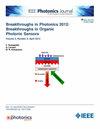A Cost-Effective and Precoding-Free Optical Frequency Multiplication Scheme for mmW Photonic Fronthauls
IF 2.4
4区 工程技术
Q3 ENGINEERING, ELECTRICAL & ELECTRONIC
引用次数: 0
Abstract
In this letter, we demonstrate a novel and cost-effective scheme for upconverting data to radiofrequency (RF) in a millimeter wave (mmW) photonic fronthaul based on optical frequency multiplication for frequency up-conversion. The approach is based on an electrical mixer and a Dual-Drive Mach-Zehnder modulator (DD-MZM) where carrier suppressed double-sideband (CS-DSB) modulation is held for mmW signal generation after photodetection. The viability of the approach is demonstrated by transmitting 5G orthogonal frequency division multiplexing (OFDM) signals with quadrature phase shift keying (QPSK) and 64-quadrature amplitude modulation (QAM) across a 3 m long radio link as well as 10 km of standard single-mode fiber (SSMF) link in the 40 GHz mmW band. We assessed the system performance by evaluating the error-vector-magnitude (EVM), also focusing on the received optical and electrical power (RoP and ReP, respectively), with minimum EVM of 2.8% for maximum RoP, while the full link leads to 3.4% in this condition. Moreover, the maximum transmission throughput of the system for full link scenario reached 692 Mb/s and 1800 Mb/s for 5G OFDM and single carrier signals, respectively. The experimental measurements confirm the robustness and simplicity of the proposed approach to be employed for future mobile mmW communication networks deployment without using precoding techniques and optical filtering.一种低成本、无预编码的毫米波光子前哨光学倍频方案
在这封信中,我们展示了一种新颖且具有成本效益的方案,用于在毫米波(mmW)光子前传中将数据上变频为射频(RF),该方案基于用于频率上变频的光倍频。该方法基于电混频器和双驱动马赫-曾德尔调制器(DD-MZM),其中载波抑制的双边带(CS-DSB)调制在光探测后用于毫米波信号的产生。通过在40ghz mmW频段通过3米长的无线电链路和10公里的标准单模光纤(SSMF)链路传输具有正交相移键控(QPSK)和64正交调幅(QAM)的5G正交频分复用(OFDM)信号,证明了该方法的可行性。我们通过评估误差矢量幅度(EVM)来评估系统性能,也关注接收的光功率和电功率(分别为RoP和ReP),最大RoP的最小EVM为2.8%,而在这种情况下,全链路导致3.4%。在全链路场景下,系统的最大传输吞吐量在5G OFDM和单载波信号下分别达到692mb /s和1800mb /s。实验测量证实了该方法的鲁棒性和简单性,可用于未来移动毫米波通信网络部署,无需使用预编码技术和光滤波。
本文章由计算机程序翻译,如有差异,请以英文原文为准。
求助全文
约1分钟内获得全文
求助全文
来源期刊

IEEE Photonics Journal
ENGINEERING, ELECTRICAL & ELECTRONIC-OPTICS
CiteScore
4.50
自引率
8.30%
发文量
489
审稿时长
1.4 months
期刊介绍:
Breakthroughs in the generation of light and in its control and utilization have given rise to the field of Photonics, a rapidly expanding area of science and technology with major technological and economic impact. Photonics integrates quantum electronics and optics to accelerate progress in the generation of novel photon sources and in their utilization in emerging applications at the micro and nano scales spanning from the far-infrared/THz to the x-ray region of the electromagnetic spectrum. IEEE Photonics Journal is an online-only journal dedicated to the rapid disclosure of top-quality peer-reviewed research at the forefront of all areas of photonics. Contributions addressing issues ranging from fundamental understanding to emerging technologies and applications are within the scope of the Journal. The Journal includes topics in: Photon sources from far infrared to X-rays, Photonics materials and engineered photonic structures, Integrated optics and optoelectronic, Ultrafast, attosecond, high field and short wavelength photonics, Biophotonics, including DNA photonics, Nanophotonics, Magnetophotonics, Fundamentals of light propagation and interaction; nonlinear effects, Optical data storage, Fiber optics and optical communications devices, systems, and technologies, Micro Opto Electro Mechanical Systems (MOEMS), Microwave photonics, Optical Sensors.
 求助内容:
求助内容: 应助结果提醒方式:
应助结果提醒方式:


